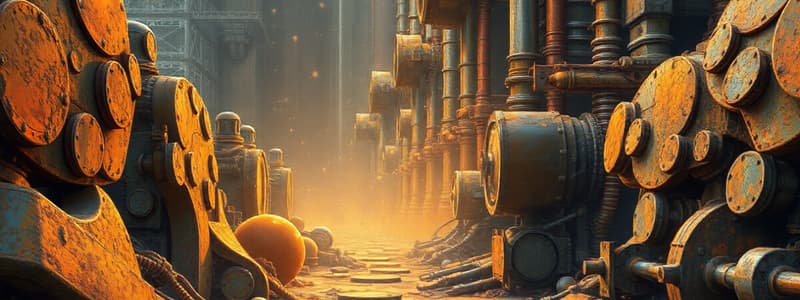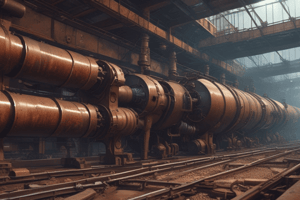Podcast
Questions and Answers
What is the main purpose of material selection in the mining industry?
What is the main purpose of material selection in the mining industry?
- To ensure maximum electrical conductivity
- To mitigate corrosion and wear-related damages (correct)
- To reduce operational costs entirely
- To improve aesthetic appearance of equipment
Which of the following best describes alloys?
Which of the following best describes alloys?
- Single-element materials with poor conductivity
- Materials that are always better than pure metals
- Pure metals with low density
- Substances formed by combining multiple elements with special properties (correct)
Which factor is NOT typically used to characterize metals?
Which factor is NOT typically used to characterize metals?
- Bright lustre
- High density
- Low thermal conductivity (correct)
- Good ductility
What is corrosion primarily defined as?
What is corrosion primarily defined as?
What role do engineers play in the context of corrosion and wear?
What role do engineers play in the context of corrosion and wear?
Which of the following is a component of tribology?
Which of the following is a component of tribology?
Which type of materials can undergo corrosion?
Which type of materials can undergo corrosion?
How can the addition of elements to pure metals be summarized?
How can the addition of elements to pure metals be summarized?
What is the primary role of the anode in an electrochemical cell during corrosion?
What is the primary role of the anode in an electrochemical cell during corrosion?
Which of the following factors is NOT necessary for electrochemical corrosion to occur?
Which of the following factors is NOT necessary for electrochemical corrosion to occur?
What product is typically generated when steel corrodes in hydrochloric acid?
What product is typically generated when steel corrodes in hydrochloric acid?
What does a negative value of Gibbs free energy (∆G) indicate about a material's susceptibility to corrosion?
What does a negative value of Gibbs free energy (∆G) indicate about a material's susceptibility to corrosion?
During the corrosion of iron, which compound is formed and commonly known as red rust?
During the corrosion of iron, which compound is formed and commonly known as red rust?
Which requirement is essential for the electrical bridge necessary for electrochemical corrosion to be completed?
Which requirement is essential for the electrical bridge necessary for electrochemical corrosion to be completed?
What is the significance of the interface between material and environment in the corrosion process?
What is the significance of the interface between material and environment in the corrosion process?
Which ions are typically involved in the corrosion of steel when placed in an acidic medium?
Which ions are typically involved in the corrosion of steel when placed in an acidic medium?
What does a more negative Gibbs energy (∆G0) indicate about a metal's dissolution rate?
What does a more negative Gibbs energy (∆G0) indicate about a metal's dissolution rate?
Which of the following statements about corrosion reactions is true?
Which of the following statements about corrosion reactions is true?
What is indicated by a positive value of Gibbs energy (∆G0) for a corrosion reaction?
What is indicated by a positive value of Gibbs energy (∆G0) for a corrosion reaction?
In the context of metal corrosion, what do the terms 𝐢→ and 𝐢← represent?
In the context of metal corrosion, what do the terms 𝐢→ and 𝐢← represent?
What does the exchange current density (𝐢𝑜) depend on according to the provided equations?
What does the exchange current density (𝐢𝑜) depend on according to the provided equations?
What characterizes the relationship between activation energy (∆G∗) and corrosion kinetics?
What characterizes the relationship between activation energy (∆G∗) and corrosion kinetics?
What can be inferred about the metal's corrosion reaction when its ΔG = 0?
What can be inferred about the metal's corrosion reaction when its ΔG = 0?
Which equation relates the electric currents and Gibbs free energy for corrosion?
Which equation relates the electric currents and Gibbs free energy for corrosion?
What is a primary reason for the high production of new steel according to the Corrosion Institute?
What is a primary reason for the high production of new steel according to the Corrosion Institute?
What is the main purpose of protective coatings in corrosion prevention?
What is the main purpose of protective coatings in corrosion prevention?
Which method controls corrosion by using a sacrificial metal?
Which method controls corrosion by using a sacrificial metal?
What is anodic protection intended to achieve?
What is anodic protection intended to achieve?
Which of the following statements about cathodic protection is true?
Which of the following statements about cathodic protection is true?
What is one disadvantage of corrosion mentioned?
What is one disadvantage of corrosion mentioned?
What are the two methods to generate cathodic current?
What are the two methods to generate cathodic current?
What is one of the financial impacts of corrosion as mentioned?
What is one of the financial impacts of corrosion as mentioned?
What happens to the anodic current density when corrosion starts on a metal?
What happens to the anodic current density when corrosion starts on a metal?
What does the term ∆G+ represent in the context of corrosion?
What does the term ∆G+ represent in the context of corrosion?
Which type of corrosion is characterized by localized attack leading to the formation of small holes or pits?
Which type of corrosion is characterized by localized attack leading to the formation of small holes or pits?
What is a key factor associated with the corrosion rate of a metal?
What is a key factor associated with the corrosion rate of a metal?
How much was the economic cost of rust estimated to be in 2016?
How much was the economic cost of rust estimated to be in 2016?
Which type of corrosion occurs due to a difference in electrochemical potential between two dissimilar metals in contact?
Which type of corrosion occurs due to a difference in electrochemical potential between two dissimilar metals in contact?
According to the information provided, what percentage of global damage cost can be saved by implementing corrosion prevention protocols?
According to the information provided, what percentage of global damage cost can be saved by implementing corrosion prevention protocols?
What is the estimated physical cost of rust in South Africa in 2013?
What is the estimated physical cost of rust in South Africa in 2013?
Flashcards are hidden until you start studying
Study Notes
Introduction
- Corrosion is a chemical or electrochemical reaction between a material and its environment that deteriorates its properties
- Corrosion can occur on metals, ceramics, or polymers
- The environments can be aqueous, non-aqueous liquids, or gases
Material Selection
- Engineers play a key role in mitigating corrosion and wear-related costs in the mining industry
- The selection of materials is one of the solutions to minimize corrosion and wear-related damages
Engineering Materials
- Engineering materials are solids useful for humankind
- Many of these materials are found in combined forms as alloys, compounds, or mixtures
- The application of pure elements is often limited
Metals and Alloys
- Metals are pure engineering materials that are bonded by metallic bonds
- Pure metals have high density, high electrical and thermal conductivity, bright luster, good ductility, malleability, and opacity
- The application of pure metals is limited due to their inherent properties
- Alloys are created by adding one or more elements to a pure metal, improving the overall properties and increasing applicability
Corrosion
- Corrosion is a reaction of a material with its environment
- This reaction can be chemical, electrochemical, physical, or a combination of these
- The material that is vulnerable can be metals, ceramics, or polymers
- The environment can be aqueous and non-aqueous liquids and gases
Electrochemical Corrosion
- The oxidation reaction occurs at the anode of an electrochemical cell
- The reduction reaction occurs at the cathode
- In the case of steel corroding in hydrochloric acid, it produces ferrous chloride and hydrogen gas
Requirements for Electrochemical Corrosion of Metal
- Metal oxidation must take place at the anode of an electrolytic cell
- The reduction of some ions must occur at the cathode
- There must be a potential applied between the anode and cathode
- An electrolyte must be present to facilitate the movement of charges
- An electrical bridge must be completed
Thermodynamic Aspects of Corrosion
- The susceptibility of a material to corrode is evaluated by the Gibbs free energy (∆G)
- The more negative the value of ∆G, the higher the susceptibility for material to corrode
- The Gibbs energy is only indicative of the tendency of the metal to corrode, not directly related to the corrosion rate
Kinetics Effect of Metals Corrosion
- Thermodynamics provides insight into the susceptibility of a system to corrode and requires an equilibrium condition with no net flow of current
- Corrosion reactions cause current to flow, so the kinetics of corrosion reactions must be considered
- The equilibrium between the anodic and cathodic reactions at an electrode is not static and the charged entities are generated and discharged concurrently at the conductive surface
Forms of Corrosion
- There are eight forms of corrosion:
- Uniform corrosion (general corrosion)
- Galvanic corrosion
- Pitting corrosion
- Crevice corrosion
- Selective leaching corrosion (parting corrosion)
- Inter-granular corrosion
- Stress corrosion
- Erosion-corrosion
Economic Cost of Corrosion
- Corrosion costs an estimated $2.5 trillion globally each year
- Implementing corrosion prevention protocols could save an estimated $375-875 billion globally
- South Africa alone saw around R130 billion in physical damage from corrosion in 2013
- Mintek and the Corrosion Institute of South Africa (CorrISA) estimate that half of each ton of steel manufactured is to simply replace rusted steel
Corrosion Impacts
- Corrosion is expensive financially
- Corrosion wastes natural resources
- Corrosion causes inconvenience to human beings
Corrosion Control
- Coatings are the most widely applied products for corrosion prevention
- Painting is used to protect metal substrates from atmospheric corrosivity
- Cathodic protection (CP) is a corrosion controlling technique which makes the surface of the metal the cathode of an electrochemical process
- This can be achieved by using connected sacrificial anodes to create a galvanic cell or by applying an external power current source
- Anodic protection involves the formation of a protective layer on metals by applying an external anodic current
Studying That Suits You
Use AI to generate personalized quizzes and flashcards to suit your learning preferences.




